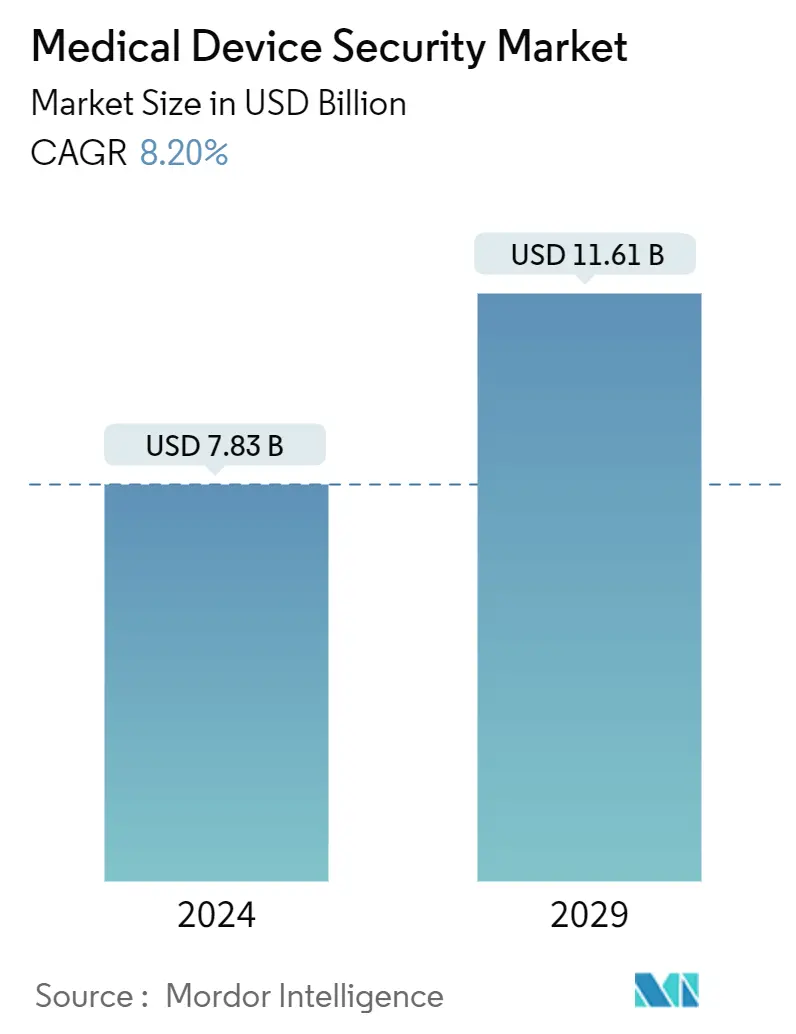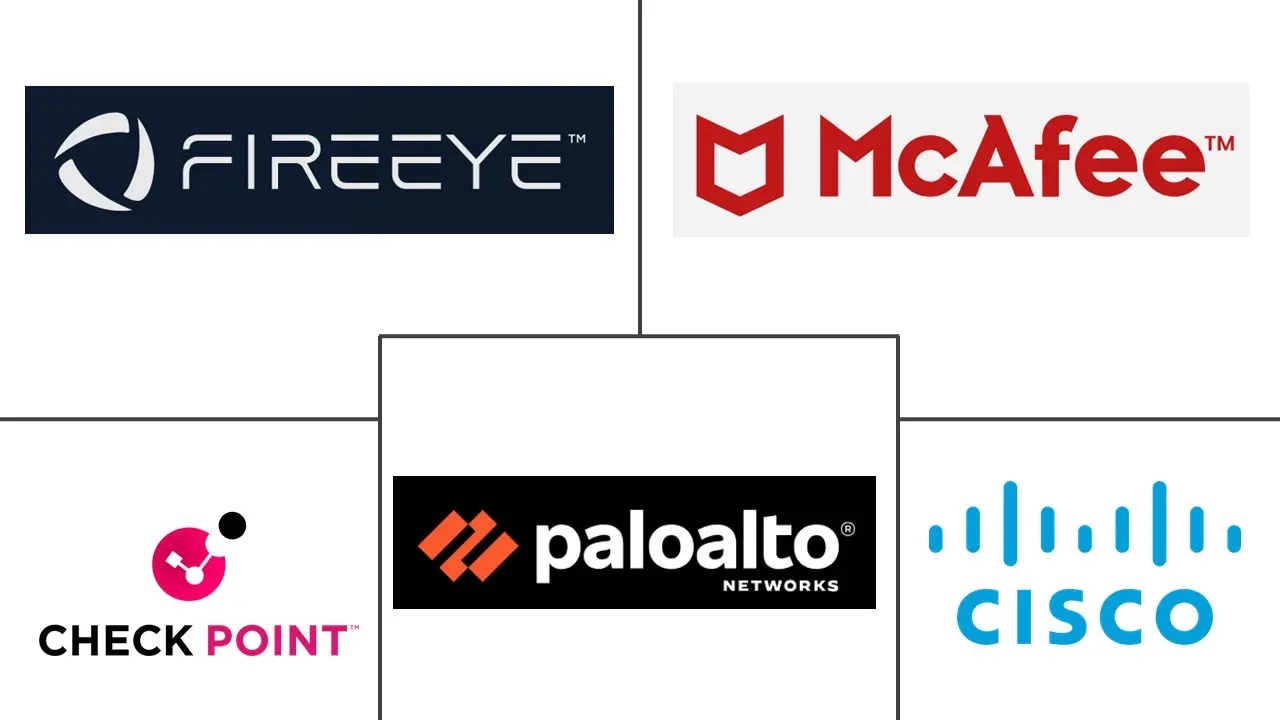Market Size of Medical Device Security Industry

| Study Period | 2019 - 2029 |
| Market Size (2024) | USD 7.83 Billion |
| Market Size (2029) | USD 11.61 Billion |
| CAGR (2024 - 2029) | 8.20 % |
| Fastest Growing Market | Asia Pacific |
| Largest Market | North America |
Major Players
*Disclaimer: Major Players sorted in no particular order |
Medical Device Security Market Analysis
The Medical Device Security Market size is estimated at USD 7.83 billion in 2024, and is expected to reach USD 11.61 billion by 2029, growing at a CAGR of 8.20% during the forecast period (2024-2029).
The healthcare industry has been witnessing a significant transformation throughout the past few years, aided by the transformative nature of IoT technologies and advancements in computing power, wireless technologies, and data analytics techniques, such as Big Data. Big Data is currently being deployed in medical facilities and the medical research sector to analyze complex heterogeneous medical data that involves proteomics, genomics, and pharmacogenomics worldwide.
- There is a rise in the number of connected medical devices and advancements in software that may capture and transmit medical data and data analytics services that help medical practitioners drive insights into and promote the delivery of predictive, preventive, personalized, and participatory medicines. The need to secure connected medical devices is rising owing to the increasing number of data breach incidents in the healthcare sector.
- The growing number of connected devices used by employees in the healthcare sector leads to more information sharing. It also places the endpoint at higher risk than ever.
- The healthcare industry is experiencing a transformation in cyber security strategy from a compliance and Health Insurance Portability and Accountability Act (HIPAA)-focused approach to a more comprehensive and security-centric approach. The governments are expected to impose stricter regulations about the safety and security of IoMT devices. Healthcare providers need to step up the game on cyber resilience.
- Cybercriminals seeking to exploit medical device and system vulnerabilities increasingly target the healthcare sector. High-profile incidents, such as ransomware attacks on hospitals, highlight the urgent need for robust cybersecurity measures. Healthcare organizations may prioritize allocating limited budgets to address immediate security threats.
- Lack of awareness about medical surveillance equipment and scarcity of monetary funds for healthcare security in underdeveloped countries are expected to hamper the growth of the medical device security market.
- Healthcare delivery organizations quickly scaled the implementations of technologies designed to support the response to COVID-19, including telehealth platforms, new fleets of medical devices, and other patient support technologies. This included temporary care sites, labs, troves of connected devices, and telehealth platforms desperately needed to support patient care.
Medical Device Security Industry Segmentation
Medical devices that are vulnerable to security threats are protected using industry-standard guidelines. Medical device manufacturers mitigate the device security risks using software solutions and services and encrypt data for secure data transfer and evading data loss. A mix of bottom-up and top-down approaches has been taken to arrive at the market estimates for this market study on the medical devices security market.
The medical device security market is segmented by solutions (data loss prevention solutions, antivirus/antimalware solutions, encryption solutions, network and endpoint security, identity and access management solutions, intrusion detection systems/intrusion prevention systems, risk and compliance management, and other solutions), device type (hospital medical devices, internally embedded medical devices, and wearable and external medical devices), and geography (North America, Europe, Asia-Pacific, Latin America, and Middle East & Africa). The report offers the market size in value terms in USD for all the abovementioned segments.
| Solution | |
| Data Loss Prevention Solutions | |
| Antivirus/Antimalware Solutions | |
| Encryption Solutions | |
| Network and Endpoint Security | |
| Identity and Access Management Solutions | |
| Intrusion Detection Systems/Intrusion Prevention Systems | |
| Risk and Compliance Management | |
| Other Solutions |
| Device Type | |
| Hospital Medical Devices | |
| Internally Embedded Medical Devices | |
| Wearable and External Medical Devices |
| Geography | |
| North America | |
| Europe | |
| Asia-Pacific | |
| Latin America | |
| Middle East & Africa |
Medical Device Security Market Size Summary
The medical device security market is poised for significant growth, driven by the increasing integration of IoT technologies and advancements in data analytics within the healthcare sector. As healthcare delivery organizations adopt smart wearables and remote monitoring equipment, the need to secure these connected devices becomes paramount. The rise in cyberattacks targeting healthcare systems underscores the urgency for robust cybersecurity measures. This shift from a compliance-focused approach to a more comprehensive security strategy is further propelled by government regulations aimed at enhancing the safety and security of Internet of Medical Things (IoMT) devices. Despite challenges such as limited awareness and funding in underdeveloped regions, the market is expected to expand as healthcare providers prioritize cyber resilience.
In North America, the medical device security market benefits from stringent regulations like HIPAA and HITECH, which drive the adoption of cybersecurity solutions. The region's advanced economy and emphasis on R&D facilitate significant investments in securing connected devices. Collaborations between key players, such as Medcrypt's partnership with Netrise and Cisco's introduction of AI-driven security solutions, highlight the industry's focus on proactive threat prevention and comprehensive security assessments. The market's fragmentation is characterized by strategic partnerships and acquisitions among major players like Check Point Software Technologies, Cisco Systems Inc., and Palo Alto Networks Inc., aiming to enhance product offerings and maintain a competitive edge.
Medical Device Security Market Size - Table of Contents
-
1. MARKET INSIGHTS
-
1.1 Market Overview
-
1.2 Industry Attractiveness - Porter's Five Forces Analysis
-
1.2.1 Bargaining Power of Suppliers
-
1.2.2 Bargaining Power of Buyers
-
1.2.3 Threat of New Entrants
-
1.2.4 Intensity of Competitive Rivalry
-
1.2.5 Threat of Substitute Products
-
-
1.3 Assessment of the Impact of COVID-19 on the Industry
-
-
2. MARKET SEGMENTATION
-
2.1 Solution
-
2.1.1 Data Loss Prevention Solutions
-
2.1.2 Antivirus/Antimalware Solutions
-
2.1.3 Encryption Solutions
-
2.1.4 Network and Endpoint Security
-
2.1.5 Identity and Access Management Solutions
-
2.1.6 Intrusion Detection Systems/Intrusion Prevention Systems
-
2.1.7 Risk and Compliance Management
-
2.1.8 Other Solutions
-
-
2.2 Device Type
-
2.2.1 Hospital Medical Devices
-
2.2.2 Internally Embedded Medical Devices
-
2.2.3 Wearable and External Medical Devices
-
-
2.3 Geography
-
2.3.1 North America
-
2.3.2 Europe
-
2.3.3 Asia-Pacific
-
2.3.4 Latin America
-
2.3.5 Middle East & Africa
-
-
Medical Device Security Market Size FAQs
How big is the Medical Device Security Market?
The Medical Device Security Market size is expected to reach USD 7.83 billion in 2024 and grow at a CAGR of 8.20% to reach USD 11.61 billion by 2029.
What is the current Medical Device Security Market size?
In 2024, the Medical Device Security Market size is expected to reach USD 7.83 billion.

